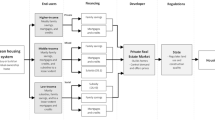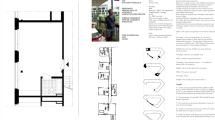Abstract
This work aims to assess whether cohousing communities might generate positive effects in terms of social housing. Cohousing projects are “supportive” communities where many types of informal support networks arise, referring to the concept of sharing spaces, facilities, but also properties, the decision-making process, and experiences. The costs of the sites and construction are often higher than a “normal condominium” (especially if they are resident-led communities), and sometimes, they might be responsible for the failure of the groups: inhabitants of those communities born spontaneously, without any kind of public aid, are mainly from a medium–high socio-economic status. However, in the UK, where cohousing follows mainly a grassroots model, some communities are able to keep the costs down, in particular by the creation of mixed tenure systems, collaboration with Housing Associations and self-building processes. The Threshold Centre in England allocates 50 % of the residential units for social housing. The collaboration with a Housing Association produced a “good housing” model, which allowed both a reduction in construction time and a guarantee of the creation of a heterogeneous group (but with a compact identity), as well as the inclusion of socio-economically vulnerable people.
Similar content being viewed by others
Notes
In Dorset (2010), housing prices are higher (£263.916) than South West (£228.940) and England (£240.033) (Office for National Statistics 2012).
References
Bamford, G. (2001). Bringing us home: cohousing and the environmental possibilities of reuniting people with neighbourhoods. University of Queensland Library. Retrieved October 23, 2010, from http://espace.library.uq.edu.au/eserv/UQ:13658/BamfordBringing2001.pdf.
Biraghi, G. (2011). Niente panico! Siamo in città… Come il cohousing può cambiare le metropoli contemporanee. Retrieved September 9, 2009, from http://www.cohousing.it/images/stories/approfondimenti/il_cohousing_e_la_citta.pdf.
Blank, J. (2001). Common meals in cohousing communities. Cohousing Journal (Winter), 20–34. Retrieved March 13, 2013, from http://www.joaniblank.com/cohousing/CommonMeals/.
Bouma, J. & Voorbij, L. (2009). Factors in social interaction in cohousing communities. In Paper presented at the Proceedings Lifecycle Design of Buildings, Systems and Materials Enschede Conference, The Netherlands.
Bourdieu, P. (1980). Le capital social: notes provisoires. Actes de la Recherche en Sciences Sociales, 31, 2–3.
Bourdieu, P. (1986). The forms of capital. In J. G. Richardson (Ed.), Handbook of theory and research for the sociology of education (pp. 241–260). New York: Greenwood Press.
Brenton, M. (1998). We’re in charge: Cohousing communities for older people in The Netherlands: Lessons for Britain?. Bristol: Policy Press.
Brenton, M. (2008). The cohousing approach to ‘lifetime neighbourhoods’. Factsheet n: Housing Learning and Improvement Network. 29.
Brown, J. R. (2004). Comparative analysis of energy consumption trends in cohousing and alternate housing arrangements. Massachusetts: Institute of Technology.
Castells, M. (1997). The power of identities the information age: Economy, society and culture (Vol. 2). Oxford: Blackwell Publishers.
Chatterton, P. (2013). Towards an agenda for post-carbon cities. Lessons from Lilac, the UK’s first ecological affordable cohousing community. International Journal of Urban and Regional Research, 37(5), 1654–1674.
Chiodi, S. (2012). Città-campagna: abitare in-comune. Sociologia Urbana e Rurale, 97, 25–36.
Coleman, J. S. (1990). Foundations of social theory. Cambridge: Harvard University Press.
Communities and Local Government (2010–2011). Mean and median weekly rents net of services by region, 2009–2010 and 2010–2011. Retrieved July 3, 2012, from http://www.communities.gov.uk/housing/housingresearch/housingsurveys/englishhousingsurvey/ehstables/ehshouseholdtables/socialprivaterenters/.
Dioguardi, G. (2001). Ripensare la città. Roma: Donzelli Editore.
Field, M. (2004). Thinking about cohousing. The creation of intentional neighborhoods. London: Diggers and Dreamers.
Francescato, D. (2010). “The Shrinking of Utopia”: dalle Comuni degli anni ‘60 al cohousing del 2000. In A. Sapio (Ed.), Famiglie, reti familiari e cohousing Verso nuovi stili del vivere, dell’abitare (pp. 173–210). Milano: Franco Angeli.
Fromm, D. (1991). Collaborative communities: Cohousing, central living and other forms of new housing with shared facilities. New York: Van Nostrad Reinhold.
Fromm, D. (2000). American cohousing: the first five years. Journal of Architectural and Planning Research, 17(2), 94–109.
Harvey, D. (1999). Justice, nature and the geography of difference. Oxford: Blackwell.
Hoch, C., & Hemmens, G. C. (1967). Linking informal and formal help: Conflict along the continuum of care. Social Service Review, 61, 432–446.
Horelli, L., & Vespa, K. (1994). In search of supportive structures for everyday life. In I. Altman & A. Churman (Eds.), Women and the environment (pp. 201–226). New York: Plenum Press.
Jarvis, H. (2011). Saving space, sharing time: integrated infrastructures of daily life in cohousing. Environment and Planning, 43, 560–577.
Karn, J. (2004). Narratives of neglect. Community, regeneration and the governance of security. Devon: Willan Publishing.
Kirby, A. (2003). Redefining social and environmental relations at the ecovillage at Ithaca: A case study. Journal of Environmental Psychology, 23, 323–332.
Lietaert, M. (2007). Cohousing e condomini solidali. Firenze: Editrice Aam Terranuova.
Lietaert, M. (2010). Cohousing’s relevance to degrowth theories. Journal of Cleaner Production, 18, 576–580.
Lietaert, M. (2011). Il cohousing: origini, storia ed evoluzione in Europa e nel mondo. Retrieved October 31, 2011, from http://www.cohousingitalia.it/article8844.htm.
Lynch, K. (1960). The image of the City. Cambridge (Mass.): Massachusetts Institute of Technology Press.
McCamant, K., & Durret, C. (2011). Creating cohousing: Building sustainable community. Canada: New Society Publichers.
McCamant, K., & Durrett, C. (1998). Cohousing: A contemporary approach to housing ourselves. Berkeley: Ten Speed Press.
Meijering, L., Huigen, P., & Van Hoven, B. (2007). Intentional communities in rural spaces. Tijdschrift voor Economische en Sociale Geografie, 98(1), 42–52.
Meltzer, G. (2005). Sustainable community: Learning from the cohousing model. Canada: Trafford.
Office for National Statistics (2012). Average weekly rents: by region. Retrieved January 12, 2013, from http://www.statistics.gov.uk/hub/index.html.
Paldam, M., & Svendsen, G. T. (2000). An essay on social capital: looking for the fire behind the smoke. European Journal of Political Economy, 16, 339–366.
Pickerill, J., & Chatterton, P. (2006). Notes towards autonomous geographies: creation, resistance and self-management as survival tactics. Progress in Human Geography, 30(6), 730–746.
Poley, L. D. (2007). Community and the habits of democratic citizenship: An investigation into civic engagement, social capital and democratic capacity-building in U.S. cohousing neighborhoods, Doctoral thesis, Virginia Polytechnic Institute and State University.
Putnam, R. D. (1993). Making democracy work: Civic traditions in modern Italy. New Jersey: Princeton University Press.
Putnam, R. D. (2000). Bowling alone: The collapse and revival of American community. New York: Simon and Schuster.
Randall, C. (2012). Measuring National well-being—Where we live—2012. England: Office for National Statistics.
Renz, M. A. (2006a). Paving consensus: Enacting, challenging, and revising the consensus process in a cohousing community. Journal of Applied Communication Research, 34(2), 163–190.
Renz, M. A. (2006b). The meaning of consensus and blocking for cohousing groups. Small Group Research, 37, 351–376.
Sargisson, L. (2010). Cohousing: A Utopian property alternative? Retrieved February 20, 2012, from http://www.psa.ac.uk/2010/UploadedPaperPDFs/1225_1085.pdf.
Sargisson, L., & Sargent, L. T. (2004). Living in Utopia: New Zealand’s intentional communities. Aldergate: Ashgate.
Scotthanson, C., & Scotthanson, K. (2005). The cohousing handbook. Building a place for community. Canada: New Society Publishers.
Tarozzi, A. (1992). Quale sociologia dello sviluppo. Sassari: Edizioni di iniziative culturali politiche sociali e sviluppo.
Tuckman, B. (1965). Developmental sequence in small group. Psychological Bulletin, 63, 384–399.
Williams, J. (2005). Designing neighbourhoods for social interaction: The case of cohousing. Journal of Urban Design, 10(2), 195–227.
Williams, J. (2008). Predicting an American future for cohousing. Futures, 40, 268–286.
Author information
Authors and Affiliations
Corresponding author
Rights and permissions
About this article
Cite this article
Ruiu, M.L. The effects of cohousing on the social housing system: the case of the Threshold Centre. J Hous and the Built Environ 30, 631–644 (2015). https://doi.org/10.1007/s10901-015-9436-7
Received:
Accepted:
Published:
Issue Date:
DOI: https://doi.org/10.1007/s10901-015-9436-7




